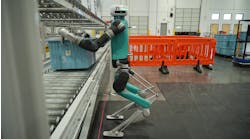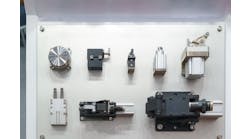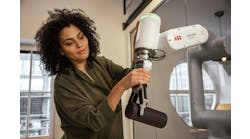I have lamented the struggles that pretty much every employer seems to be facing these days—the lack of available people to fill positions on our production lines. For some employers, this issue is hitting critical mass. A booming economy has forced companies to ramp up production lines, and, for those that don’t have mothballed equipment, that means running more shifts or extended hours to try and meet client demand. Behind all the good news about reduced unemployment there are people in boardrooms trying to figure out how to meet expectations with an ever-dwindling pool of available people.
As control designers, our traditional role of making things smarter and faster appears to have taken a backseat as manufacturers need to find ways to produce more with the same or fewer people operating the equipment. For me, in my position as controls engineer for a major co-packager, I am suddenly faced with an ownership group that has switched gears from keeping things running while investing some capital in upgrades to finding ways to consolidate production techniques so that we can make more product with the same number of people.
In simpler times—or at least they seem simpler when looking back from our current vantage point—streamlining production involved picking key operations and doing a study to determine if any part of it is a good candidate for change. Studies usually took weeks or months, after which there would be meetings to digest the gathered information and formulate a plan to move forward. Vendors would be solicited for proposed solutions, and more meetings would convene to pore over the resultant information. Successful bids would be turned into projects; contracts awarded; and the journey from concept to product would begin. The projects of the past were strung out and methodical, with plenty of time to chew on the dynamic aspects before bringing everything to a successful conclusion.
The U-turn in manufacturing seems to have caught most producers a little flat-footed. The ability to provide a ready workforce has met many challenges, and the result is nothing short of a panic to get control of supply and demand. The traditional project timeline is greatly reduced, and the demand on designers to get projects from concept to widgets out the door to the client is highly charged. Some equipment vendors have risen to that challenge and are ready and willing to fill the needs in a well-thought-out manner, and it is that vision that needs sharing.
Filling the needs
As a producer of food products, my company has always depended on a largely hands-on workforce to meet client needs for products. During peak seasons we have traditionally been able to reach out to the local area and bring in temporary employees to meet the additional production numbers. A number of factors have created a situation where people simply aren’t available. The solution for us is to look at automating jobs, where possible, so that we can use those same people to do other tasks. In the past, the impetus to do such a thing was hard to fathom because why would we spend capital on new machines or processes for a temporary upswing in product demand.
For many years, the yearly trips to the trade shows involved walking by the many booths displaying various products that have evolved into what is now collectively known as collaborative robots. While I consider myself somewhat savvy when it comes to automation, I have always viewed collaborative robots as something that only the big players would get involved with.
I found it hard to imagine a situation where I would want to stand on a production line where a fully automated machine would interact with me, mimicking human actions, to produce products. Don’t get me wrong. Robots have had a place in the automotive and plastics industries for years, but my view of them has been these large, completely guarded work cells where dangerous functions such as welding and fabrication took place. My earlier career involved many such designs and installations. I always marveled at the ability of a robot to manipulate large objects with great ease.
The primary difference between those early robots and those we see in action today is the ability to interact in a manner that is as intimate as physically handing a box to a robot that puts it on a pallet. Gone are the heavy fences and gates of physical barriers.
The robot of today uses technology that senses the proximity of objects and restricts or disables function based on how close the live object is to the robot work envelope. This fact is key to the consideration of collaborative robots (cobots) in a food production plant such as the one where I work.
Working with robots
As with any emerging technology, there is much to sort out, especially on the safety side of things. Two documents, ANSI/RIA R15.06 and ISO 10218, define safety protocols relative to collaborative robots, but further refinement will follow as the technology continues to evolve.
Primary techniques in this regard are the limiting of power and force in collaborative robots. Due to operating in close proximity to live subjects, collaborative robots are restricted from operating at full power, so that they can be easily stopped should they come into contact with humans.
Elaborate sensors are deployed to ensure the safety of people. These come in the form of area scanners for the broad area, which define general areas of operation, further narrowed down by more finite sensors that use force feedback to detect when the robot appendages come into contact with a person.
The latest technology involves tactile feedback that can actually react to metal contact on skin. Some manufacturers are using these sensors to stop the action of the robot entirely whereas others are using that same sensing technology to tell the robot to actually move back in the opposite direction slightly before stopping. Imagine this to be much like what happens when we bump into a person in real life. The automatic response is to pull back from the source of contact.
The continuing refinement in the interaction of humans and robots is extremely important in the evolution of the product. Protection of life and limb is paramount to the presence of cobots on the production line. People need to feel safe if we are going to expect them to work around these inanimate objects.
With the rapidly advancing technology with respect to cobots, companies like the one I where I work are now considering cobots to be a viable solution to the problem of staffing a production line. Our lines have been operating for more than 60 years, and, for the greater part of that time, we have relied on physical labor to produce the finished product.
As machines became more elaborate, the footprint required to contain the operation has grown, but the building walls have not. There is more and more in the same finite space. Consideration of a robot on a mature production line is most often eliminated due to the lack of sufficient space. Cobots answer this concern by presenting automation in an envelope not much bigger than the human that currently performs the same function.
With the specific safety features of today’s cobot, a person can work pretty much right beside a cobot in complete confidence that the cobot is not going to harm them.
One of the challenges facing any company that is hoping to incorporate cobots in the work environment is to sort through the myriad choices out there. This is a hugely competitive field at the moment, and, while everyone tries to remain professional about it, it doesn’t take too much conversation with a potential vendor to hear “cute” and “amateur” used to describe their competitors’ product.
The bottom line is this is an emerging technology. Innovation comes in many forms and can come from the strangest of origins. Don’t be afraid to entertain many presentations before jumping into the fray. One vendor, who was trying hard not to slag a competing solution, actually saved us a pile of trouble because the competing vendor actually filed for Chapter 11 protection just a couple of months after giving us a great presentation on their products and services.
Cobot application guidelines
Here are some guidelines to help with understanding the application of cobots and how one might select a potential solution.
-
Size is relative. The attractive part of a cobot is the notion of squeezing it into the same footprint as the human currently doing a particular job. Other items on this list can quickly make the size of the robot an issue.
-
Keep the payloads in perspective. The higher the payload—weight of the object being manipulated—the larger the robot will need to be to do the job.
-
Speed is everything. The automatic leaping-off point with the use of automation is to make the function or process faster. The downside is, the faster the object gets flung around, the bigger the robot needs to be to handle the load.
-
Be prepared to share the work. Proper studies by your vendor will likely reveal that a robot sitting at the end of your line might spend a fair bit of time twiddling its thumbs, so to speak. Don’t be afraid to look at sharing a cobot between adjacent lines to optimize the asset.
-
Look for a value-added solution. There are a couple of popular cobots out there, and they are quite capable of being quickly set up to run an application. However, some vendors have taken a further step to add a layer over top of the basic programming interface to make the installation even easier to use. What you want to avoid is having to have your end users become robot specialists. A good vendor will make your solution so easy even a manager can use it.
Goals as part of selection
The key in selecting where to apply cobots is to stay focused on the goal. For most companies, the goal is to free up people to use in other facets of the operations. Short of naming each robot after the person they are replacing, the objective should be to create a solution that takes up no greater space than a person. The return on investment is, after all, based on freeing up people to meet the demands of your customers. The more elaborate the installation, the greater the cost will be to install it. Bear in mind that we don’t want to create a burden on another department, especially maintenance, by installing something that shifts the use of resources from the operator to someone with a greater skill set that might be even more time-constrained.
Earlier, I mentioned the impulse to improve speed when going to cobots. While this would be great, in reality there are likely limitations on other equipment in your application that would quickly be the bottleneck, preventing your extra expense from ever providing a return on investment. There’s no sense paying for something you aren’t going to use.
While we have yet to issue a purchase order, our company has found the fact-finding experience to be a great benefit. We set out with some specific areas of interest where we were sure to make a quick return on investment, and, while this turned out to be true for some, the deeper dive into our operations exposed some unanticipated gems. Our list of potential solutions has nearly doubled and we are excited to get the first system or systems into place in our facilities. The more we think about obvious areas to use cobots, the more we think about other functions that once seemed completely out of consideration and now seem to be great next steps in the process.
Finally, we can be easily convinced to go with the lowest-cost solution when trying to supplement physical labor with collaborative robot solutions. Our own research has revealed that some vendors whom we thought would be on the high end of our vendor list from a cost-per-installation point of view turned out to be the most economical. The greater surprise was the length to which these vendors have gone to fully divest in this emerging technology. Their solutions are well-thought-out, and the install base was much larger than we imagined. The journey has just begun, but we feel like we are joining a great fraternity of companies who have seen the light when it comes to the use of robots with humans in our operations. We are eager to see these solutions in action.






